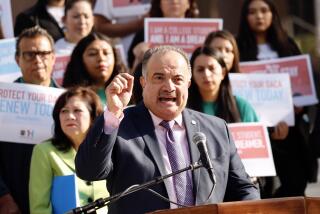Not-So-Golden Years
El Camino College, which has one of the largest community college campuses in the nation, is celebrating its golden anniversary starting this month, but not everyone is in the mood to party.
Over the last 15 years, student enrollment at the school in Torrance has dropped nearly one third, from 30,800 students in the early 1980s to 21,640 students in 1995.
The collegeâs professors, who used to be among the highest paid community college teachers in the state, now rank toward the middle, with hundreds of part-time professors teaching classes.
State funds for the college have dwindled so much that recruiters are traveling to Taiwan, Japan, Korea and South America searching for students who can pay out-of-state tuition.
And morale among the faculty, professors say, is at its lowest in years. âIâve been here since 1972 and I tell you, I was very proud [of the college] until the last couple of years,â said Abe Levine, a sociology professor.
Many of these problems, particularly the decline in state money and student enrollment, are mirrored across the vast network of Californiaâs 106 community colleges as the recession affected the economy, and fees for classes more than doubled from 1991 to 1993, to $13 a unit. The result has been an 11% decline in student enrollment across California since 1991.
El Camino College was founded in 1946 when an influx of World War II veterans on the GI Bill were eager for education. The first building was not an academic edifice but a stadium because stipulations in a land grant said the property must be used for recreational purposes. Temporary quarters were set up at Redondo Beach High School and Leuzinger High School. The halls of learning would come a few years later.
And when the college built those halls of learning, they paid for it up front with property tax funds. No money was borrowed. No long-term bonds were floated. They paid cash.
*
El Camino College became one of the stateâs most stable colleges because of its policy of save first, build later. As the South Bay region grew with the booming aerospace industry and new industry, graduating high school seniors from the South Bay scrambled to sign up at the two-year institution.
But a demographic shift in the South Bay population, with an aging population that wasnât moving out of the area, led to fewer high school students going on to El Camino College. It was bad news for a college that gets $3,000 from the state for each full-time equivalent student on campus.
The stateâs contribution to college revenues declined $4 million in five years leading to some cost trimming measures. When professors went to the bargaining table in 1992 to discuss a salary raise, what they got was a long and bitter contract dispute that lasted two years. With no salary increase since 1991, they got a three-year contract that gave them a 3.25 % pay raise beginning in January 1995. Instructors earn $35,000 to $59,000 per academic year. But the pay increase came after the faculty union agreed to a 40% decrease in summer school salaries.
The meager pay raise and the bitter contract dispute between administration and faculty have left its mark.
âThe result has been an awful lot of demoralized and angry faculty,â said Lance Widman, a political science professor at the college for 25 years and the former president of the El Camino College Federation of Teachers. âMorale doesnât go into the toilet overnight, and it doesnât come out of it fairly quickly.â
But Mary Ann Keating, director of public information for the college, said that faculty morale may have been low two years ago but is better now. âI would say faculty morale is higher than Iâve seen it in several years,â she said.
Another sticking point among the faculty has been the tendency for school administrators to hire more part-time instructors who earn about 60% of what a full-time professor makes. Keating notes that part-time instructors are found at every college in California.
*
At El Camino College, there are about 290 full-time professors and 490 part-time instructors, according to a recent report submitted to the Western Assn. of Schools and Colleges. To comply with state law, the full-timers teach at least 75% of the class hours.
There are some bright spots in the collegeâs future.
Victor Hanson, head of fiscal services, said the state payments will fall by just $250,000 this coming academic year.
The collegeâs library finished an $8-million expansion last year that added 60 computers and more than doubled the space.
A new college president, Thomas Fallo, was appointed last year to replace Sam Schauerman, who was president for eight years. One of the first things Fallo did was give the faculty an unexpected 1% additional pay increase starting in January 1996. He instituted a âTuesday at 2 With Tom program,â in which his door is open to anyone who wants to talk. And he also put $400,000 into new technology and computers.
Despite the rough times, professors feel the college is still a gem for South Bay residents, who have used El Camino to improve their skills, get a toehold into the university system or to retrain themselves in an ever-changing job market.
More to Read
Sign up for Essential California
The most important California stories and recommendations in your inbox every morning.
You may occasionally receive promotional content from the Los Angeles Times.










